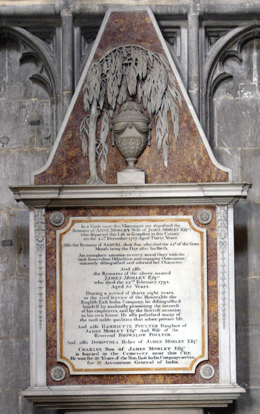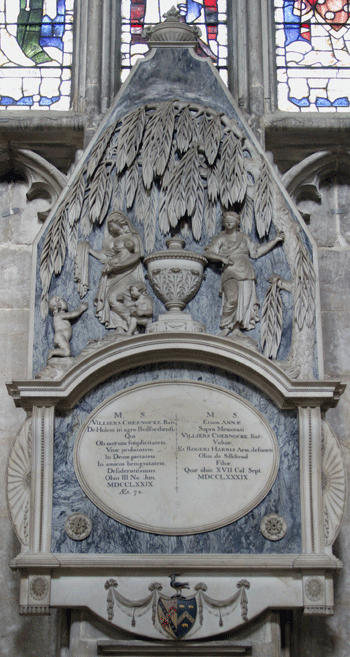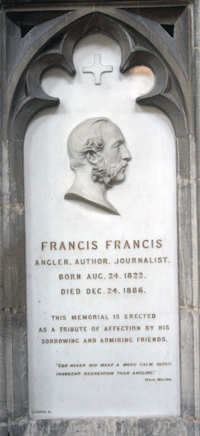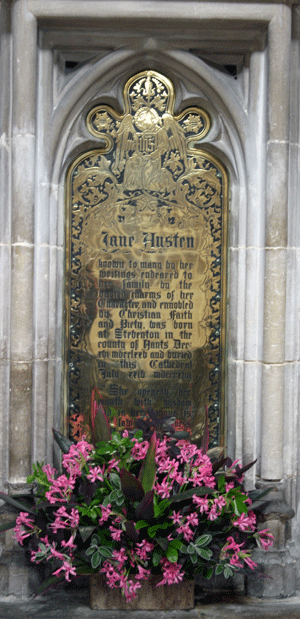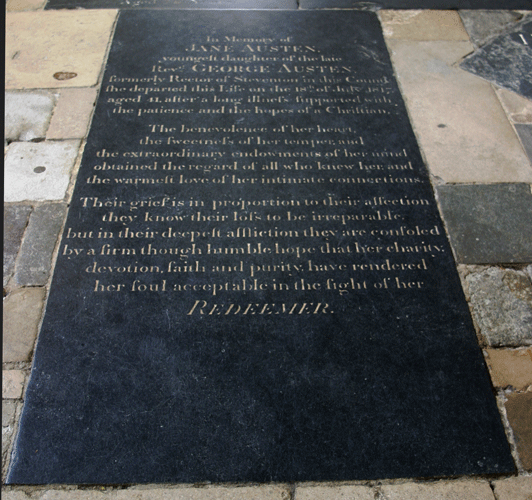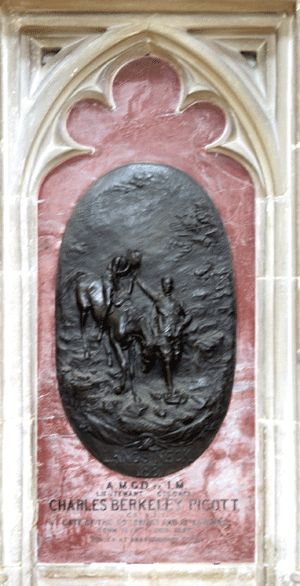| HAMPSHIRE - CITY OF WINCHESTER |
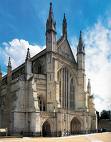 |
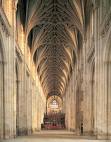 |
Winchester Cathedral |
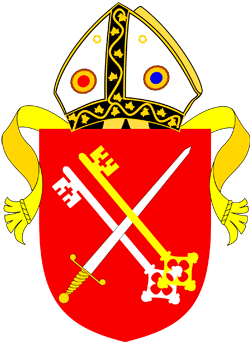 |
 |
| Park in one of the city's long stay car parks about 2/3
mile from the city centre. There is an entrance fee of
£5.00 - which is also the cost of an annual pass. There
is no extra charge for photography. Please note these
charges may now not be the same. The staff are very
friendly and welcoming. Please note: this is a large page: be patient! The ledger stones have been moved to another page, see below. |
Winchester Cathedral - or, more properly, The Cathedral Church of The Holy Trinity, Saints Peter, Paul and Swithun - is a Cathedral of the New Foundation; at the Reformation it was a Benedictine Cathedral Priory. The See was actually founded at Dorchester-on-Thames in 635 but moved to Winchester in 679. See below
| Kings, Queens, Princes |
| Æthelwulf Cenweahl Cnut Cynegils Ecgberht Edmund Edred Emma Harðicnut Prince William William Rufus |
|
Some Notes on the Religious Foundations in Winchester |
|
Around 648 Cynegils, King of Wessex, built a church in
Winchester, which came to be known as The Old Minster. The actual
see was originally founded at Dorchester in Oxfordshire in 635
but was moved to Winchester in 679 when the church became a
Cathedral Church. The Old Minster acted as a burial place for
the Kings of Wessex and Bishops of Winchester. This church was
enlarged by Bishop Athelwold, being rededicated in 980 and again
in 993. In 1079 Walkelin, the first Norman Bishop of Winchester, began a new church which was ready for worship in 1093. The Old Minster was abandoned and demolished, although the bones of the various kings and bishops were translated to this new church, which survives in part as the Winchester Cathedral of today. The Old Minster was situated north of the nave of the present church and was excavated between 1961 and 1966 by the archaeologist Martin Biddle; these excavations are described in The Old Minster; Excavations near Winchester Cathedral 1961 by Martin Biddle (Winchester 1970). King Alfred and his Queen founded two monastic churches in Winchester. Alfred's foundation - The New Minster - was close to the Old Minster, so close, in fact, that singing from the one church is said to have disturbed those in the other and, according to William of Malmesbury, effected a rivalry which led to 'frequent injuries on either side'! Alfred's Queen founded the Abbey of St Mary, usually known as The Nuns' Minster. These two churches were completed by Alfred's son, King Edward the Elder, and the Anglo-Saxon Chronicle records that the New Minster was consecrated in 903. William of Malmesbury writes that King Alfred was firstly buried in the Old Minster because the New Minster was not yet ready at the time of his death. When the New Minster was completed, Edward removed his father's body for reburial in the new church. Alfred's Queen, although she died in the Nuns' Minster, of which she became abbess, was also buried there. Edward himself was also buried in the New Minster as was King Edwy at a later time. And there they remained until William Giffard removed the New Minster to Hyde - a suburb of Winchester - in 1110 (time of Henry I). The bodies of Alfred, his Queen and Edward the Elder were translated to Hyde, being taken in procession by the monks to their new home - now know as Hyde Abbey. The New Minster itself was demolished. At Hyde Abbey they rested in peace in until the Dissolution of the Monastries when the abbey fell into lay hands, the church was demolished and the graves lost. The possible sites of the graves were found in recent excavations but the contents and any monuments have been lost. Click here for a fairly light hearted investigation of the whole story |
| Lady Chapel | South-East (Bishop Langdon's Chapel) |
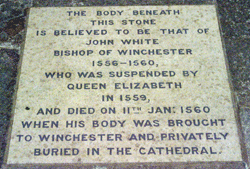 Above: This is a modern stone to Bishop White (1560). A coffin was found in this position which was assumed to be his . He was headmaster of Winchester College, where he prepared a memorial brass in the chapel, and later Bishop of Winchester under Mary I. He fell into disfavour under Elizabeth I and was deprived of his see in 1559, six months before his death. Right: Bishop Langton (1500) The Purbeck Marble tomb chest fills the chapel. The lid has a brass indent. Arms carved on the chest. He was elected Archbishop of Canterbury but died of the plague a few days later. |
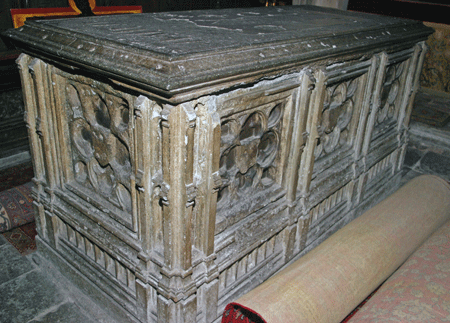 |
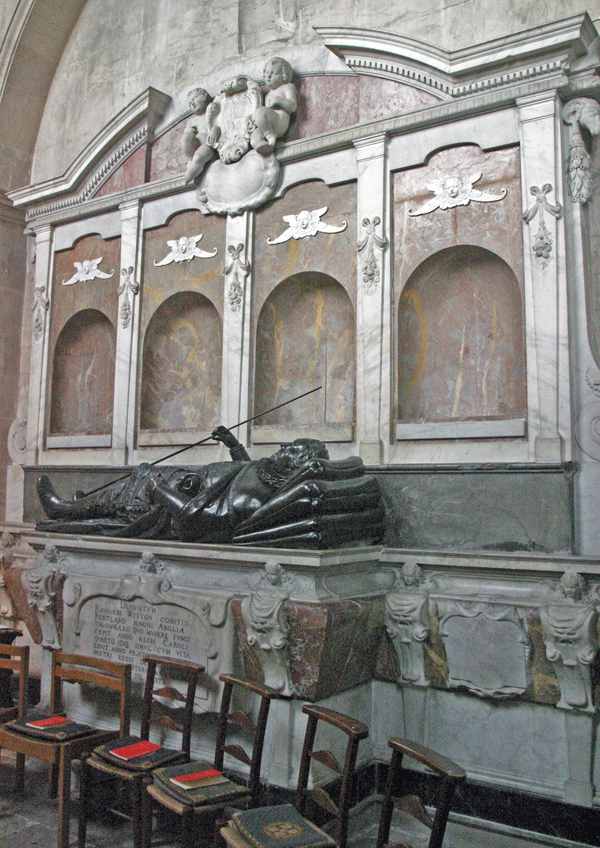 |
 Bishop Peter Mews (1706) Fought at Naseby, where he was taken prisoner. After the Execution of Charles I, retired to Holland where he acted as Royalist agent. As a reward was awarded many ecclesiastical preferments. Fought at Sedgemore for James II where he was wounded and afterwards wore a black patch over his cheek to hide the scar. Buried in the Earl of Portland's vault. He is said to have neglected his diocese |
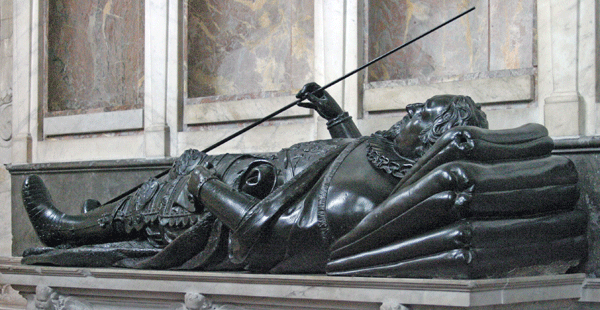 |
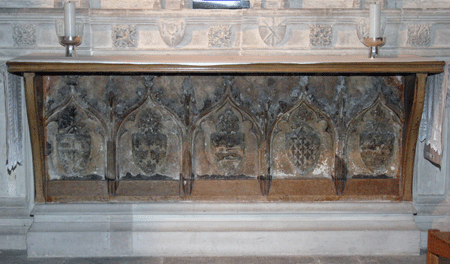 |
| Richard Weston, Lord Portland (1634) A large monuments with a bronze effigy by Le Sueur. A minister of Charles I who eventually became Lord High Treasurer of England - among many other posts - and a most unpopular man: the prime agent of iniquity as he was called in the House of Commons by John Eliot | Arnold de Gaveston (early 14th C) This is the front only, showing shields with arms, of a Purbeck marble tomb chest. The corresponding effigy is in the retrochoir (qv) |
| Retrochoir - Nave |
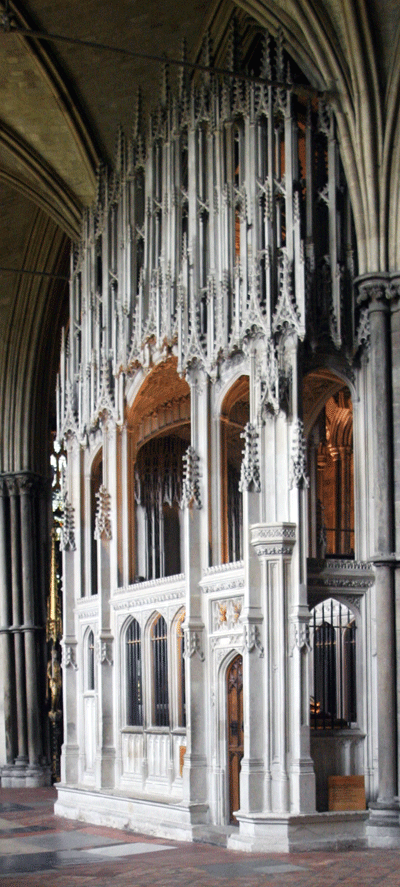 |
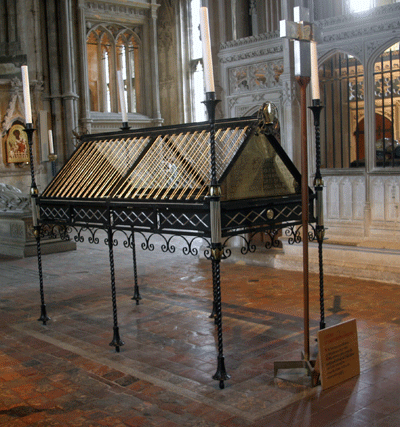 |
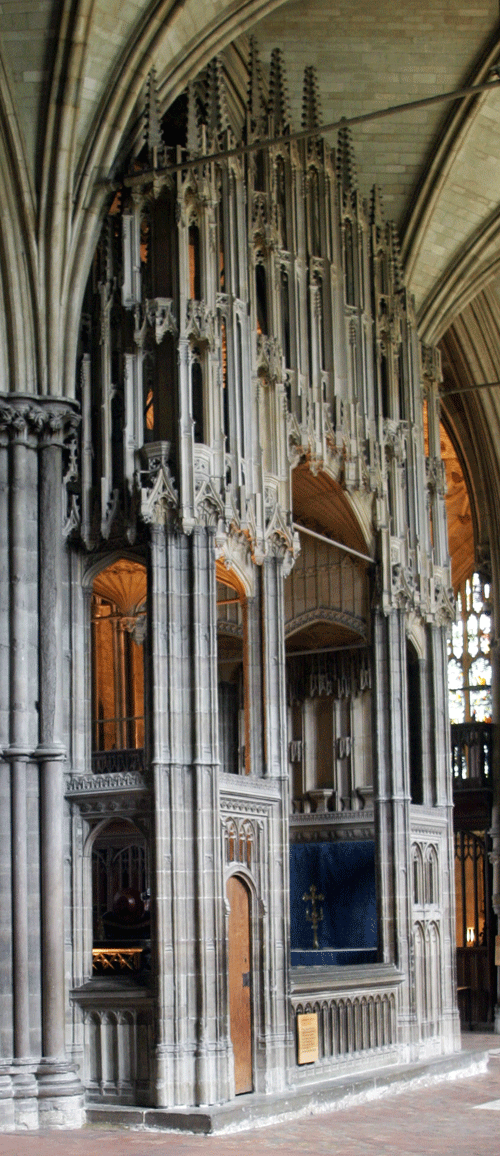 |
|
Above: Saint Swithun's 'Shrine' The acutal shrine
was destroyed at the Dissolution. This structure, over a
inscription on the floor, is by Brian Thomas & Wilfred
Carpenter Turner 1962 . Left: Bishop Waynflete's Chantry Chapel. Note the stone grill effectively closing the chapel off, unlike that of Cardinal Beaufort. Right: Cardinal Beaufort's Chantry Chapel. Unlike the chapel of Bishop Waynflete, this chapel is open. |
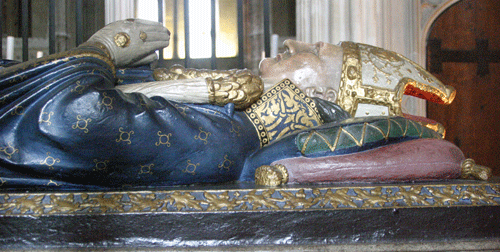 Above: Bishop Waynflete (1486) Chantry Chapel & Effigy. The effigy was repainted in 1932. Arms but inscription lost. He was the first provost of Eton, founder of Magdelene College, Oxford and chanceller under Henry VI |
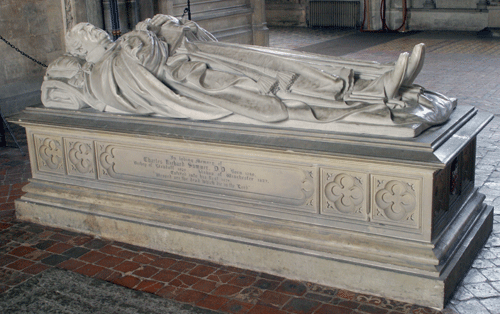 |
 Cardinal Beaufort (1477) Chantry Chapel and Effigy. The rather crude effigy is 17th century work, possibly being a copy of that destroyed in 1642 by William Waller's army when the cathedral was ransacked. Arms but brass inscription lost. Son of John of Gaunt, half-bother to Henry IV; weathy and more of a statesman and soldier than an ecclesiastic. Persecuted the Lollards and took part in the trial of Joan of Arc whose image now looks down on him! |
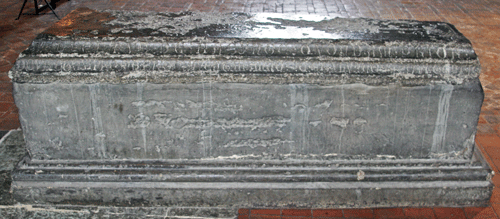 |
Above:
Bishop Charles Richard Sumner (1874)
cenotaph by Henry Weekes 1876 Left: Prior William de Basyng (1295) The slab is carved with a foliated cross and a mitre: a mitred prior is unusual but the privilage was conferred by Pope Innocent IV in 1254. Inscription around three sides of the edge of the lid. See below. Right: Bishop Godfrey de Lucy (1204) Plain Purbeck slab but with matrices of sockets to hold candles. Son of Richard, Chief Justiciar of Henry I Other Monuments in this Site 1. large slab with brass matrix of an ecclesiastic, on floor west of St Swithun's Shrine |
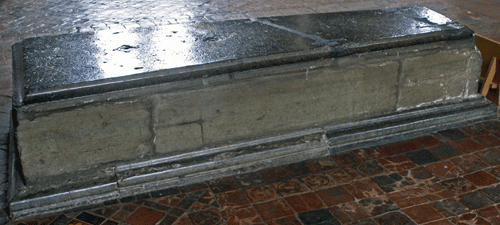 |
Inscription on the William de Basyng Tomb: HIC JACET WILLELMUS DE BASYNGE QVANDAM PRIOR ISTIVS ECCLESIE CVJVS ANIME PROPICIETVR DEVS: ET QVI ANIMA EJVS ORAVERIT III ANNOS C ET XLV DIES INDULGENCIÆ PERCIPIET (Here lies William de Basinge, formerly Prior of this church, on whose soul may God have mercy: and whosoever shall pray for his soul shall obtain an indulgence of three years, one hundred and forty-five days) |
|
Note: The Romanesque apse was demolished in the early 14th century and the present straight screen constucted, the entrance to the Holy Hole, under a platform behind the screen, forming a central and unusual feature. Along the front of the screen is cut an inscription: The bodies of saints lie here buried in peace, From whose merits many miracles shine forth. A row of canopied niches, which orginally contained statues removed at the Reformation, can be seen in this screen. Below these niches are cut a series of names: Kinegilsus Rex; Sanctus Birinus Episcopus; Kinewaldus Rex; Egbertus Rex, Adulphus Rex; Eluredus Rex, filius eius; Edwardus Rex Senior; Adthelstantus Rex, filius eius; Sancta Maria; Dominus Iesus; Edredus Rex; Edgarus Rex; Emma Regina; Alwinus Episcopus; Ethelredus Rex; Sanctus Edwardus Rex, filius eius; Cnutus Rex; Hardecnutus Rex, filius eius. It is said that these statuettes were probably intended to commemorate the kings and bishops whose bones originally lay in chests on the platform above but are now in the mortuary chests. However it includes some who were certainly not buried at Winchester and well as Jesus and the Virgin Mary. It thus may be intended as a display statues of preconquest kings and others not at all related to burials |
| Retrochoir - North Aisle |
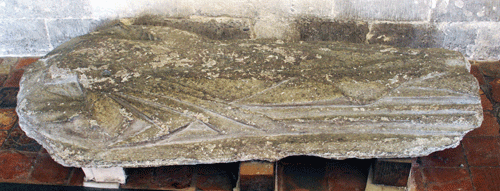 Torso of bishop or prior 13th century |
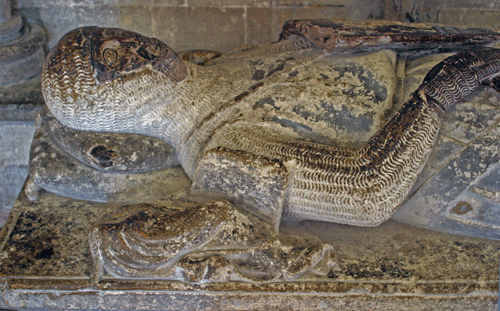 |
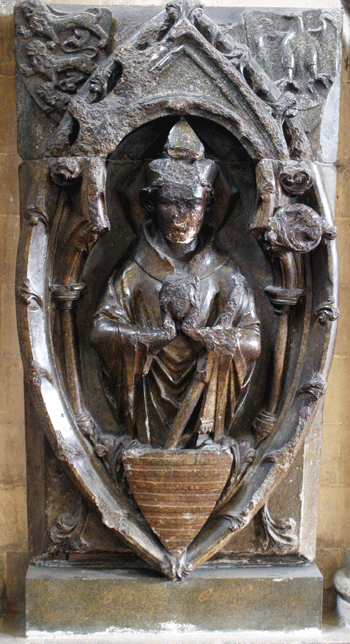 |
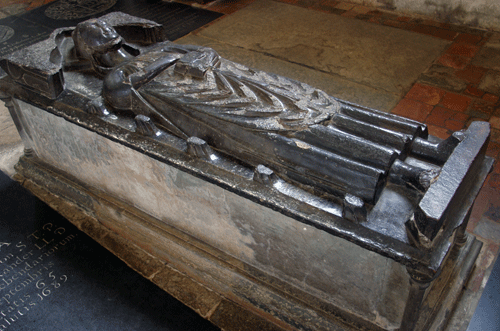 |
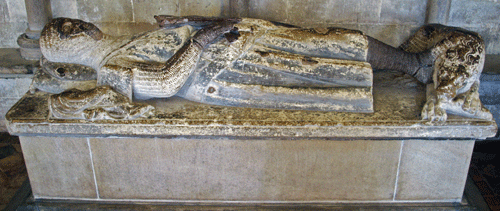 Arnold de Gaveston (early 14th C). Father of Piers Gaveston, favourite of Edward II. Effigy only lying on a modern tomb chest. A panel of the original tomb chest is now in the North-East Chapel. Note tha 'ailettes' (Fr. 'little wings') visible between the upper part of the arm and knee of the damaged angel in the above photographs. These appear between 1290 and 1325 and are quite rare on effigies. They are rectangular, flat or slightly curved structures made of either boiled leather or wood. They may serve to protect the shoulders or be a purely heraldic device. |
| Retrochoir - South Aisle |
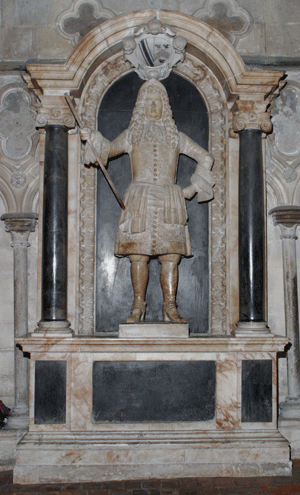 |
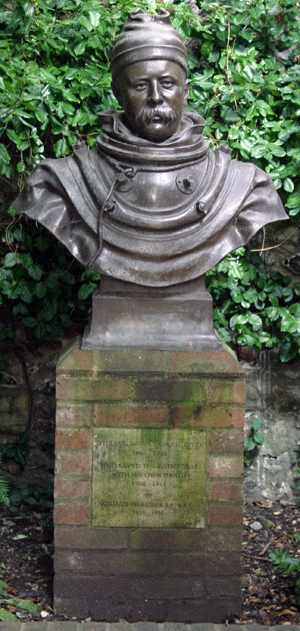 |
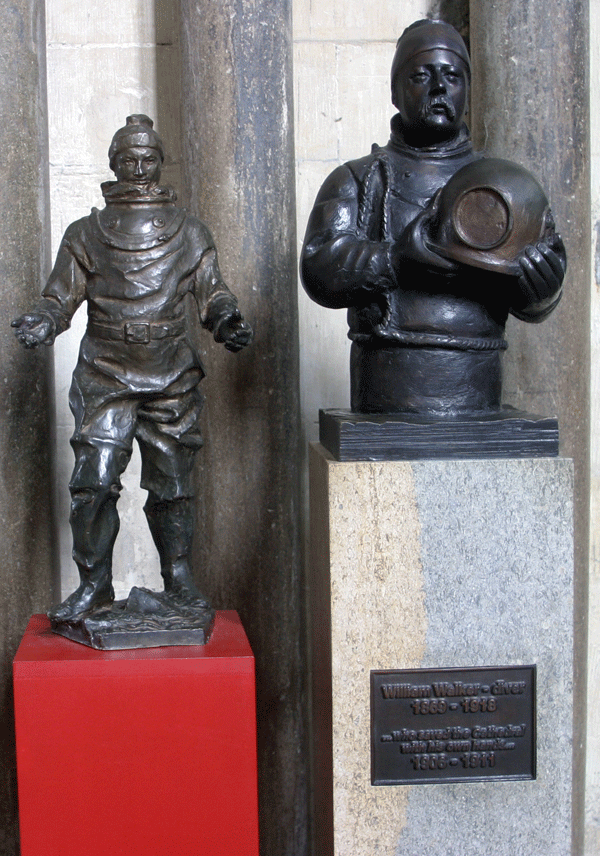 |
| Sir John Clobery MP (1687) Alabaster by Sir William Wilson. His stone is lost but those of his children remain and are listed in this section. | William Walker (1918) The famous Diver of Winchester Cathedral. The bronze in the centre has been in the Cathedral for over 25 years; that to the right was recently donated by a visitor as a more accurate portrait taken from his photographs. The bust on the left - a very accurate representation - is in the grounds | |
| The Choir |
These chests are on the top of the choir screens, three to the north and three to the south. I have described them as a plan with east upwards. In this section I have dealt with what can be seen; click here for further information about them. Below are photographs of the chests with an attempted transcription of the inscriptions and their translation. Notes the the letter N has been reversed on the eastern and central chests but not in the later western ones. Note also the various attempts to include all the inscriptions. I have used the spellings of the Anglo-Saxon and Anglo-Danish names as they appear in The Handbook of British Chronology. |
| NORTH SIDE - EAST CHEST | SOUTH SIDE - EAST CHEST | ||
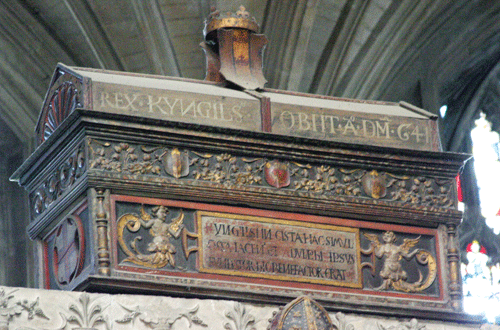 |
Choir Side REX·KYNGILS·OBIIT ·A°· DM 641 (King Cynegils died A.D. 641) KYNGILSI IN CISTA HAC SIMVL OSSA IACENT ET ADVLPHI IPSVS FVNDATOR HIC BENEFACTOR ERAT (The bones of Cynegils and Æthelwulf lie together in this chest - the former was the founder, the latter was the benefactor of this church.) |
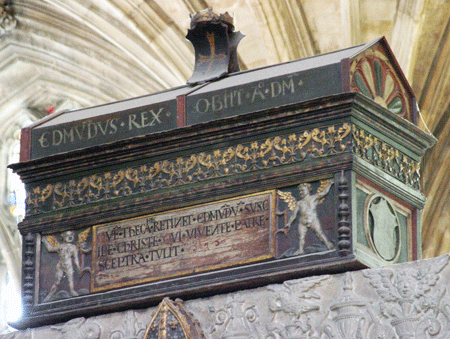 |
Choir Side EDMVDUS·REX·OBIIT·A°·DM QVE·THECAHEC·RETINET· EDMVDV·SVSC IPE·CHRISTE·QVI·VIVENTE· PATRE SCEPTRA·TVLIT· |
 |
Aisle Side ADVLPHVS·R OBIT A· DM 857 (King Ethelwolf died A.D 857) KYNGILSI IN CISTA HAC SIMOL OSSO IACENT ET ADVLPHI IPSIVS FVNDATOR HIC BENEFACTOR ERAT (The bones of Cynegils and Æthelwulf lie together in this chest - the former was the founder, the latter was the benefactor of this church.) |
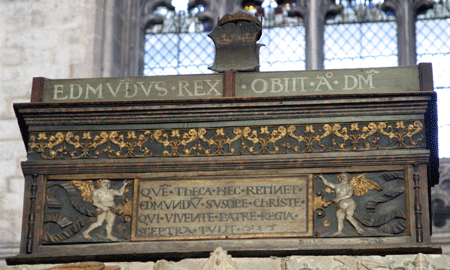 |
Aisle Side EDMVDUS·REX·OBIIT·A°·DM (King Edmund died AD ____ ) QVE·THECA·HEC·RETINET· EDMVNDV·SVSCIPE·CHRISTE· QVI·VIVENTE·PATRE·REGIA· SCEPTRA·TVLIT· (Him who this chest contains and who swayed the royal scepter while his father was yet living, do thou, O Christ, receive.) |
| NORTH SIDE - CENTRAL CHEST | SOUTH SIDE - CENTRAL CHEST | ||
 |
Choir
Side EGBERTVS REX OBIT·AM. 837 (King Ecgberht died A.D 837) HIC·REX·EGBERTVS·PAV SAT·CV·REGE·KENVLPHO NOBIS·EGREGIA·MVNERA·VIO·TVLIT ( Here King Ecgberht rests, together with King Cenwealh. Each of them bestowed great wealth upon us) |
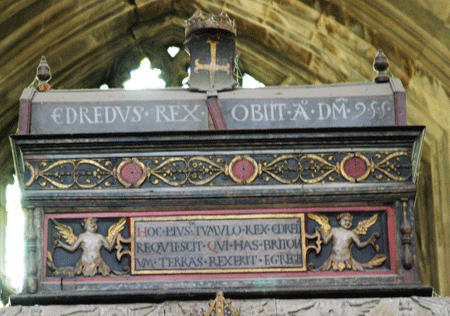 |
Choir
Side
EDREDVS·REX·OBIIT·A°·DM ·9·5·5· (King Eadred died AD 955) HOC·PIVS IN·TVMVLO·REX·EDRED REQVIESCIT·QVI·HAS·BRITON VM ·TERRAS·REXERIT ·EGREGIE (The pious King Edred rests in this tomb who admirablly governed this country of the Britons) |
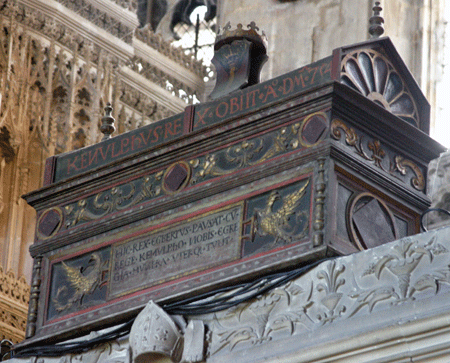 |
Aisle Side KENVLPHVS·REX·OBIT·Aº·DM·714 (King Cynewulf died A D 714) HIC·REX· EGBERTVS PAVSAT·CV· REGE·KENVLPHO·NOBIS· EGRE GIA·MVNERA·VIERO·TVLIT· ( Here King Ecgberht rests, together with King Cenwealh. Each of them bestowed great wealth upon us) |
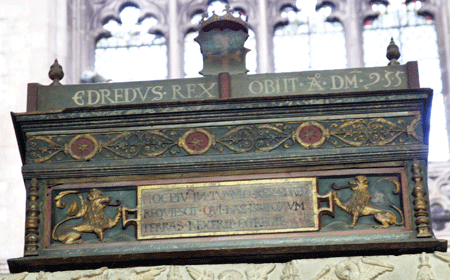 |
Aisle Side
·EDRED REQVIESCIT· (The pious King Edred rests in this tomb who admirablly governed this country of the Britons) |
| NORTH SIDE - WEST CHEST | SOUTH SIDE - WEST CHEST | ||
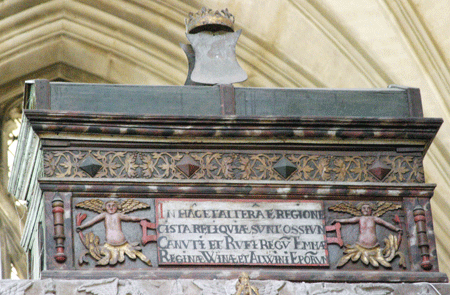 |
Choir Side IN HAC ET ALTERA E REGIONE CISTA RELIQVIÆ SVNT OSSIUM CANVTI ET RVFI REGV EMMÆ REGINÆ WINA ET ALWINI EPORVM (In this chest and in that opposite to it on the other side are the remains of Cnut and of Rufus, Kings, Emma, Queen; and of Wine and Ælfwine, Bishops. ) |
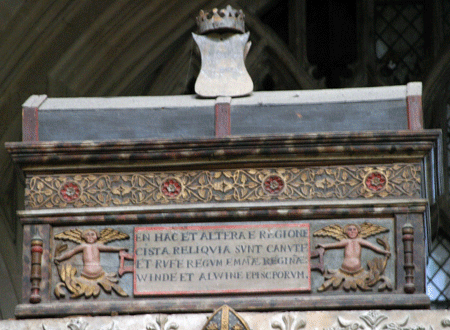 |
Choir Side (In this chest and in that opposite to it on the other side are the remains of Cnut and of Rufus, Kings, Emma, Queen; and of Wine and Ælfwine, Bishops. ) |
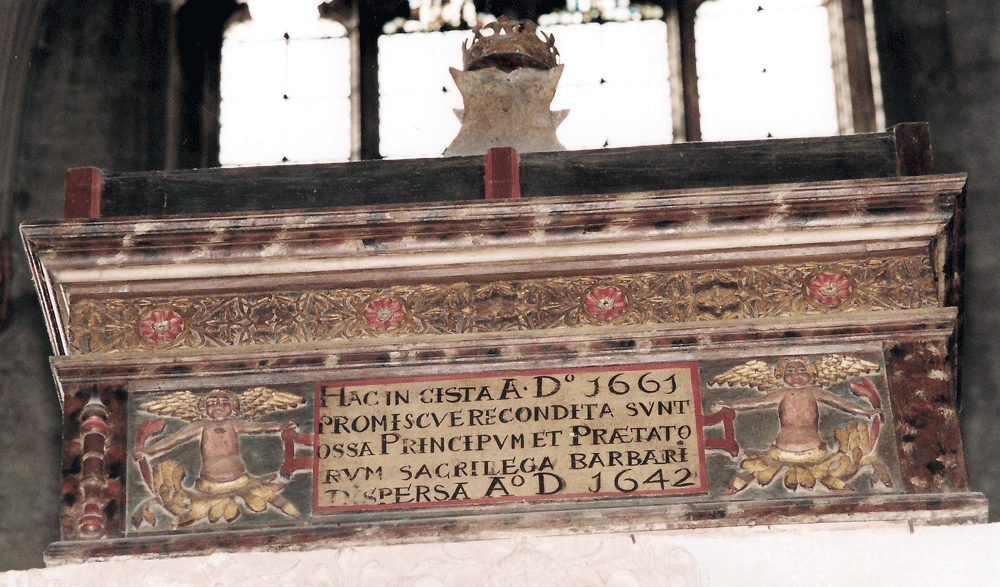 |
Aisle Side
(In this chest A.D. 1661 were promiscuously laid together the bones of princes and prelates, which had been scattered about by sacriligious barbarism in the year 1642) |
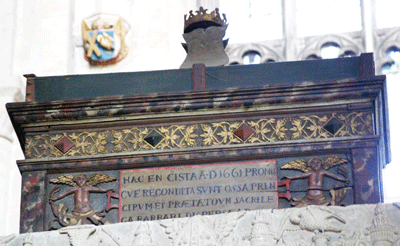 |
Aisle Side HAC IN CISTA A·D 1661º PROMISCVE RECONDITA SVNT OSSA PRINCIPVM ET PRÆTATO RVM SACRILE GA BARBARI DISPERSA AºD 1642 In this chest A.D. 1661 were promiscuously laid together the bones of princes and prelates, which had been scattered about by sacriligious barbarism in the year 1642) |
| The 'King Edmund' Stone | The 'William Rufus' Tomb |
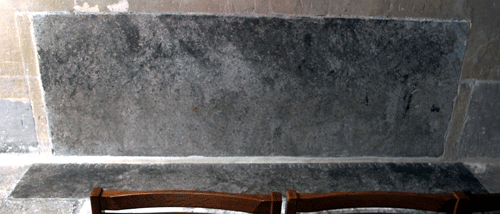 |
 |
| Not in situ; this stone is
now set in the stone seating below the screen on
the south side of the choir. It is the
approximate length of a grave slab. Click
here for further information about this
stone. The insciption can just be made out in
the photograph: HIC IACET EDMUNDUS REX EÞELREDI REGIS FILIUS (Here lies King Edmund, son of King Ethelred) |
This well known tomb with the Purbeck marble lid is traditionally said to be that of King William ('Rufus') II, who was accidentally killed while hunting in the New Forest. He was buried under the tower which promptly collapsed: an act of divine wrath directed against the king, or at least the wrath of the monastic chroniclers! The tomb has been moved and opened on several occasions. There are varying accounts of its contents but it is now considered to be more likely that of Bishop Henry de Blois. William Rufus's bones may well be in one of the mortuary chests. |
| Bishop Fox's Chantry and Bishop Gardener's Chantry | ||
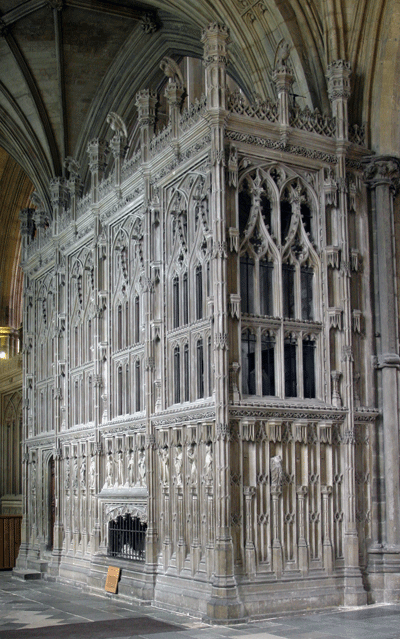 |
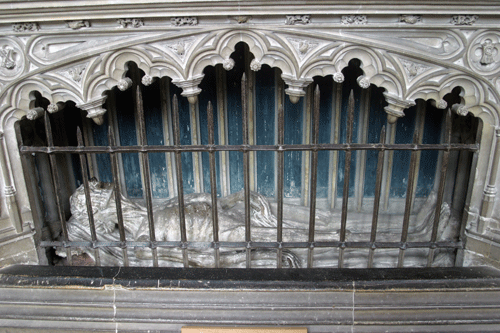
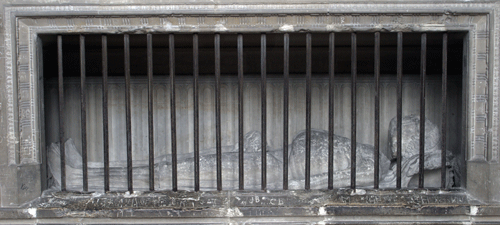 |
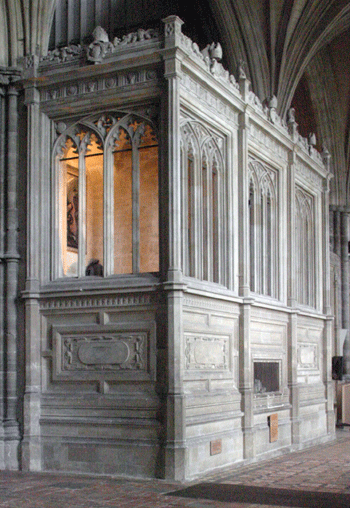 |
Left & Above Top: Richard Fox ( 1528). Secretary to Henry VII & Henry VIII. Founder of Corpus Christi College, Oxford. Builder of screen and choir aisles. Grave excavated in 1820 when his coffin containing inscription on vellum found. Corpse effigy. Right & Above Bottom: Stephen Gardener (1555) Chancellor of Queen Mary I and known as the 'Hammer of the Heretics'. Note how his corpse effigy has suffered much damage compared with that of Bishop Fox. |
||
| Medieval Bishops | ||
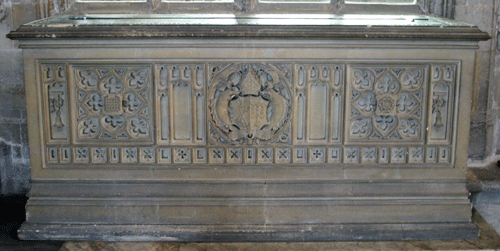 |
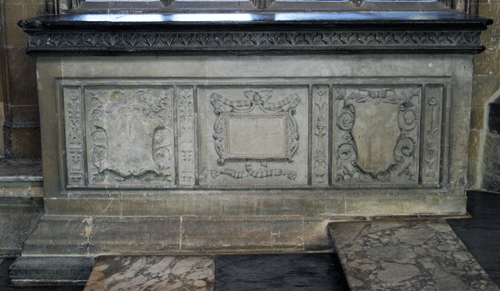 |
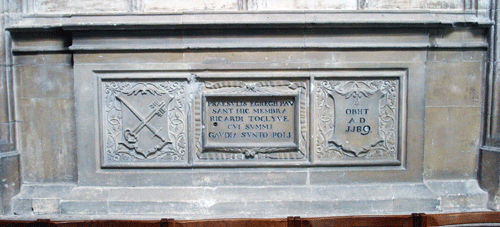 |
| Bishop Courtenay (1492) He was originally buried in the North East Chapel but his lead coffin was removed and placed in the crypt when this chapel became the Weston burial place (time: Charles I). Moved to present position by Dean Kitchen when the tomb chest was constructed; the lid with its matrix of a large cross is 15th century | Bishop John of Pontoise (1304)
The
tomb passes through the screen and appears in the aisle,
where there is an inscription. (see below) The main part
of the tomb chest is c 1525 but the lid and base are
early 14th century. See below for other side |
Bishop Richard Toclyve (1189). This
tomb chest is let into the choir screen and dates from
about 1525. This inscription reads: PRÆSULIS EGREGII PAUSANT RICARDI TOCLYVE CUI SUMMI GAUDIA SUNTO POLI (Here rest the remains of good Bishop Toclyve; may he enjoy the bliss of heaven) |
| Modern Bishops & Deans | |||
 |
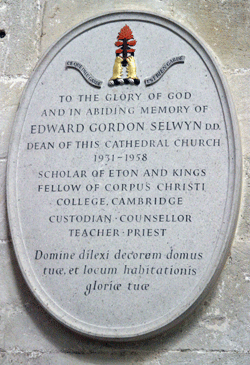 |
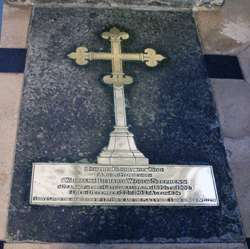
|
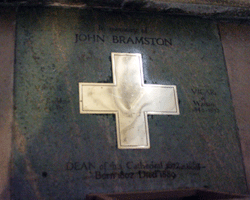 |
Far Left: Bishop Lancelot Andrews (1555-1626). Bishop 1618-1626. Buried in Southwark Cathedral. Left: Dean Edward Gordon Selwyn DD. He was Dean 1931-1958 Above Left: Dean William Richard Wood Stephens (1902) He was Dean 1895-1902 Above Right: Dean John Bramston (1889) |
|||
| Two modern wall monuments | Two modern floor brasses at the head and foot of the 'Rufus Tomb' | ||
| North Choir Aisle |
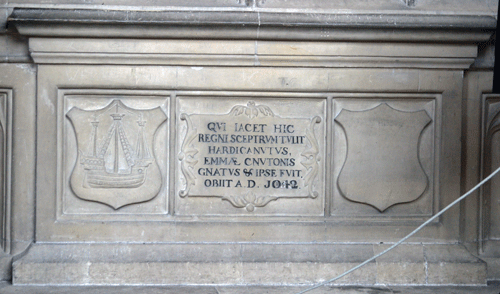 |
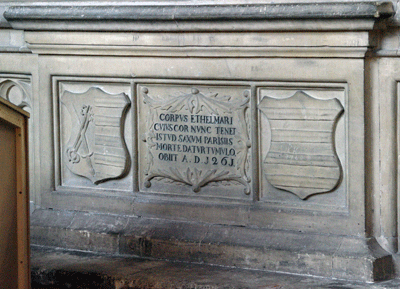 |
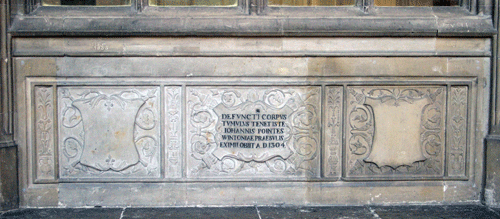 |
|
King Hardicanute (1042) QVI IACET HIC REGNI SCEPTRVM TVIIT HARDICANVTVS EMMÆ CNVTONIS GNATVS & IPSE FVIT OBIIT. A. D. J042 (He who lies here, by name Hardicanute, bore the sceptre of the kingdom, being the son of Emma and Canute. He died AD 1042 |
Bishop Bishop Audemar, Aymer or Ethelmar de
Valance (1260) CORPUS ETHELMARI CVIVS COR NUNC TENET ISTVD SAXVM PARISIIS MORTE DATVR TVMVLO OBIIT A.D. J26J (The body of Ethelmar, whose heart this stone now contains, died and was entombed in Paris. He died AD 1261) This is presumably the original site of the heart burial recorded by Fox. The Bishop was highly unpopular and was lavished with preferements by Henry III. He election - at twenty-three - to Winchester was forced on the monks by the King. He was eventually consecrated in 1260 - having been ordained priest the day before - but died soon afterwards. |
Bishop John of Pontoise (1304) DEFVNCTI CORPVS TVMVLVS TENET ISTE JOANNIS POINTES WINTONIÆ PRÆSVLIS EXIMII. OBIT 1304 (This tomb contains the body of John Pointes, an excellent bishop of Winchester, who died 1304) This is the other side of the tomb - see above |
| Some Modern Wall Monuments |
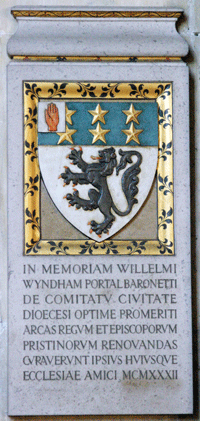 |
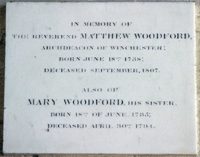 |
|
|
Left:
Archdeacon Mathew Woodford MA (1807)
& his sister
Mary Above: Sir William Wyndham Portal (1932) |
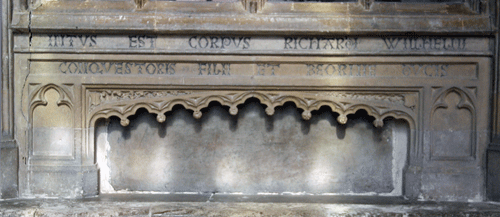 |
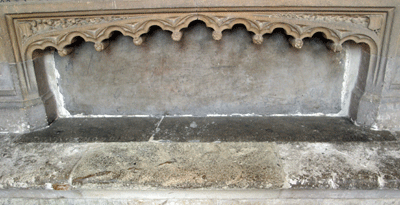 |
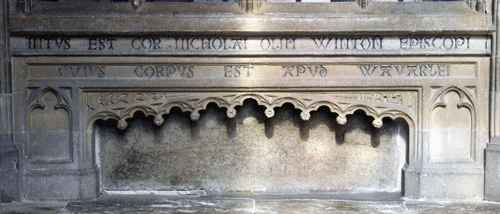 |
|
Prince William, Son of William the Conqueror He was accidentally killed while hunting in the New Forest. The original coffin with inscription can just be seen: HIC JACET RICHARDUS WILLHELMI SENIORIS REGIS FILLI ET BEORN DUX (Here lies Richard, son of King William the Elder and Duke of Beornia) On the wall above: INTVS EST CORPVS RICHARI WILLHELMI CONQVESTORIS FILII ET BEORNÆ DUC (Within this wall is the body of Richard, son of William the Conqueror and Duke of Beornia. |
Bishop Nicholas (1280) INTVS EST COR NOCHOLAI OLIII WINTON EPISCOPI CVIVS CORPVS EST APUD WAVARLEI (Within this wall is the heart of Nicholas, late Bishop of Winchester, whose body lies at Waverely) |
|
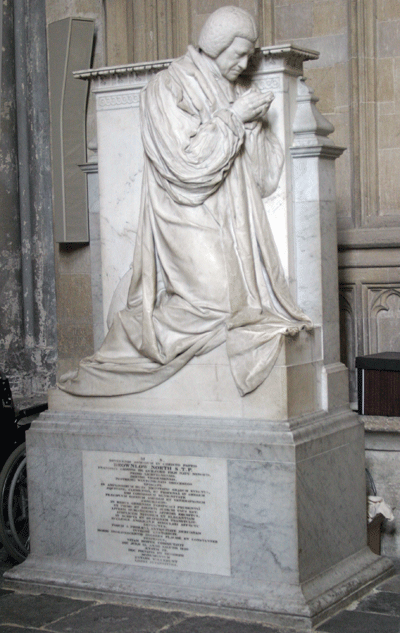 |
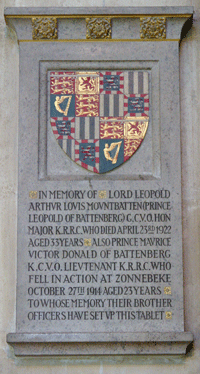 Above: Lord Leopold Arthur Louis Mountbatten (1922) & Prince Maurice Victor Donald of Battenberg (killed in action 1914) Left: Bishop Brownlow North (1820) by Chantrey; the Latin inscription was written by Dean Rennell. He is buried with his wife in the nave. The bishop was a Trollope like character: he owed his bishopric - from which he drew the vast revenues for over 40 years - to his half-brother, Lord North, the Prime Minister. For some years he resided in Italy with his fasionable wife. |
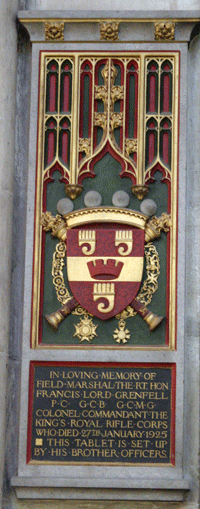
Above: Field Marshal Francis Lord Grenfell (1925) |
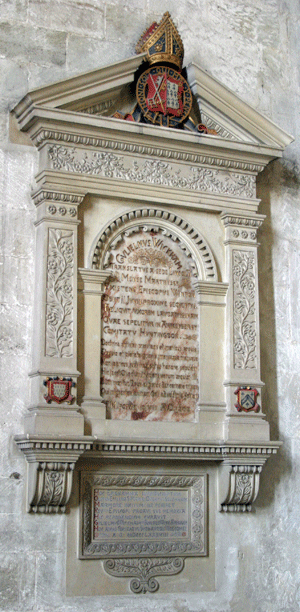 Above: Bishop William Wickham (1595) He was buried in Southwark Cathedral. RighttTop: Captain William Joseph Wickham (killed in action Ypres 1914) & his brother Captain Cyril Henry Wickham (died of wounds 1915) Bottom: Dr Huntingford 1906 Copper-gilt tablet by Kempe. He was headmaster of Eagle House School, Hammersmith and honorary canon of the cathedral. |
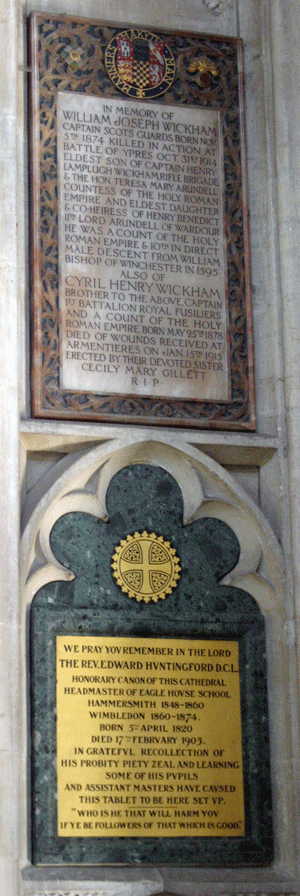 |
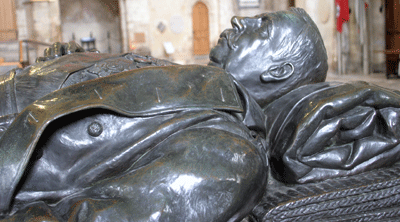 General Sir Redvers Buller VC (1908) Cenotaph with bronze effigy by Sir Bernard Mackennal 1910. See the Devon pages for wall monuments in Exeter and Crediton and the General's grave in Crediton. Far Right: Prebendary Frederick Iremonger (1820) Cenotaph by Chantrey. Inscription by Dean Rennell. Buried at Wherwell. Educationalist and man of compassion; he died at 39. |
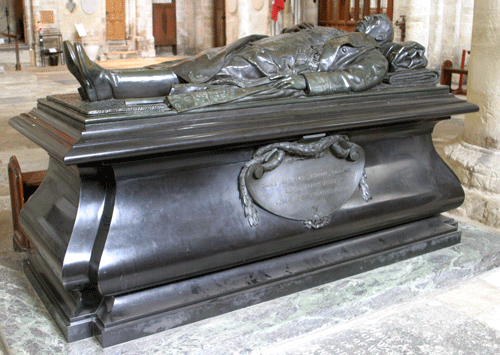 |
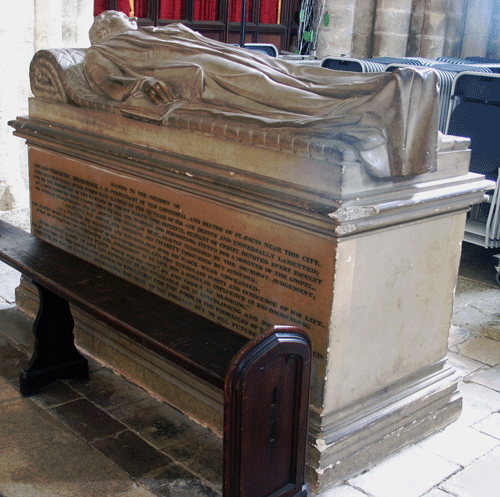 |
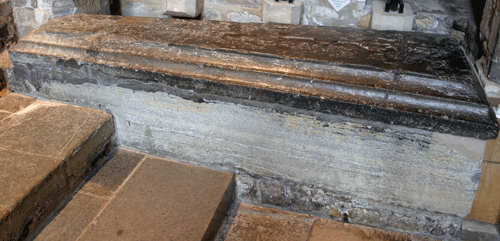 |
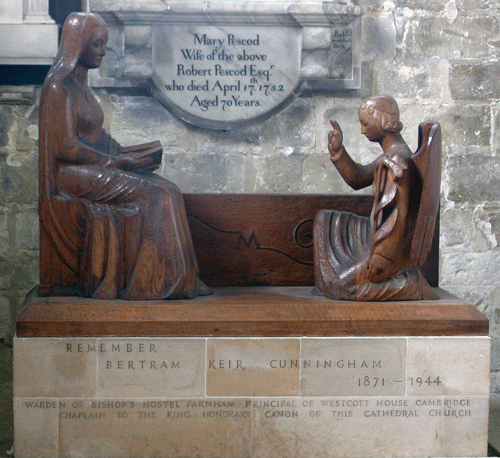 |
| Above: Purbeck marble coffin lid with foliated
cross said to be that of
Prior Roger of Normandy (early 13th century) Right: Canon Bertram Kier Cunningham (1944) Wood by Alan Durst. Behind tablet to Mary Pescod (1732) (East Aisle) Unfortunately part of this area was roped off for safety reasons and I was unable to photograph the monuments there. I will complete this on my next visit. |
| South Transept - Nave |
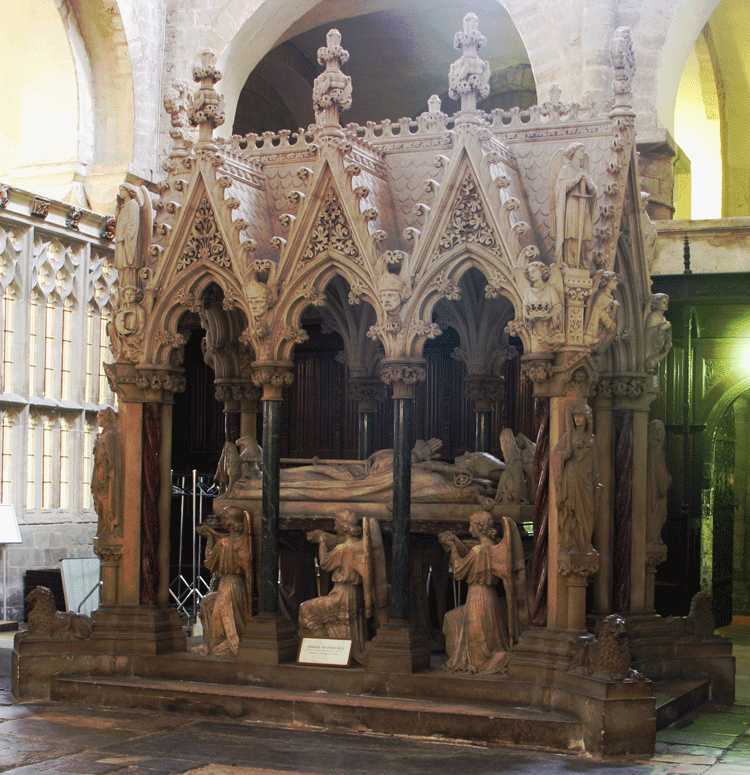 |
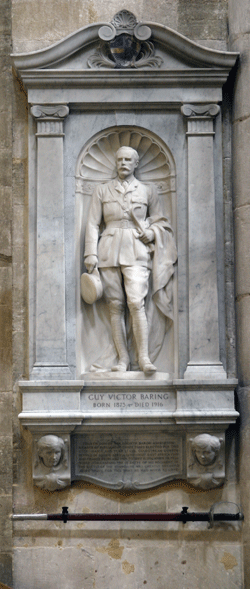 |
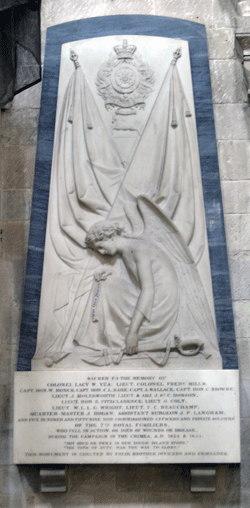 |
| Bishop Samuel Wilberforce (1873) Monument designed by Sir G G Scott; sculpted by H H Armstead 1878. Son of the anti-slavery campaigner . Known as 'Soapy Sam' and who, according to Disraeli, ...'is more odious...than Archbishop Laud.' He died in a riding accident and was buried in Lavington church yard. | Colonel Guy Baring (killed in action, Somme 1916) | Colonel Lacy W Yeo & Others (1854-5) All killed in action, died of wounds or disease in the Crimea Campaign. |
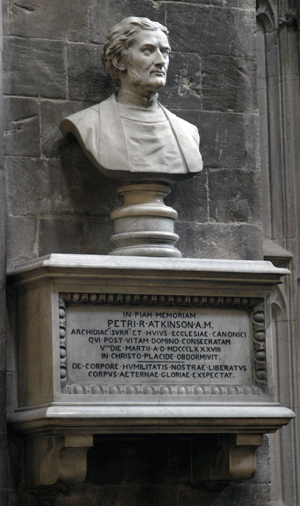 |
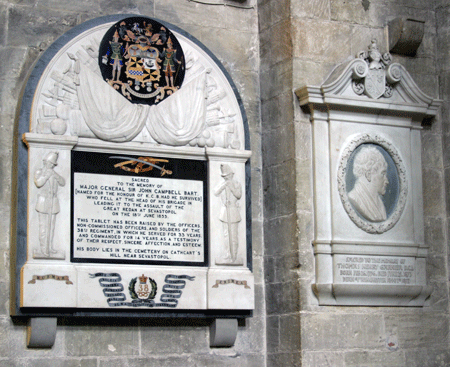 |
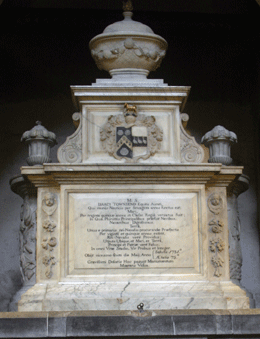 |
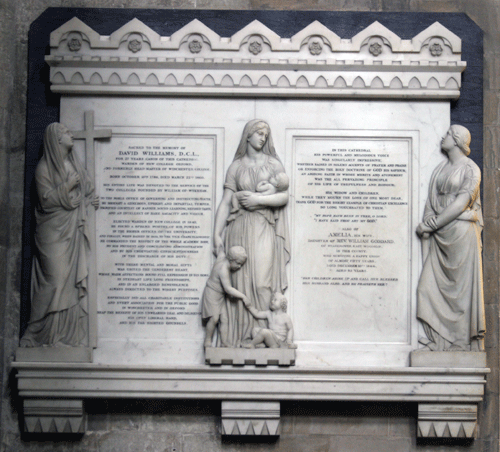 |
| Left: Archdeacon Peter Atkinson (1888) . Above from Left to Right :1.Major General Sir John Campbell (killed in action, Sevastopol 1855) 2. Dean Garnier (1812) by Richard Cockle Lucas 3. Admiral Sir Issac Townsend (1731) One of the few naval monuments in the Cathedral. 4. David Williams (1860) White marble showing Faith, Hope and Charity by W Theed. Headmaster and later warden of New College, Oxford where he was buried in the antechapel. | |||
| South Transept - Chapels |
| North Chapel | South Chapel | |||
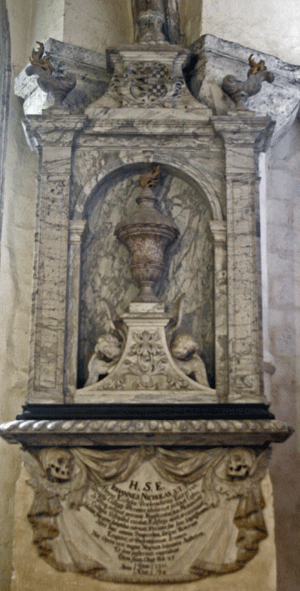 |
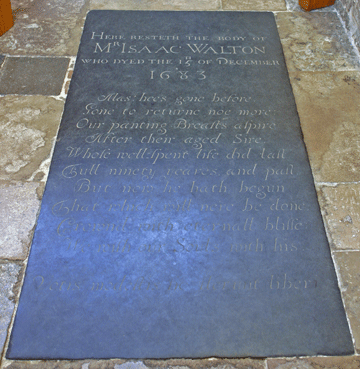 |
 |
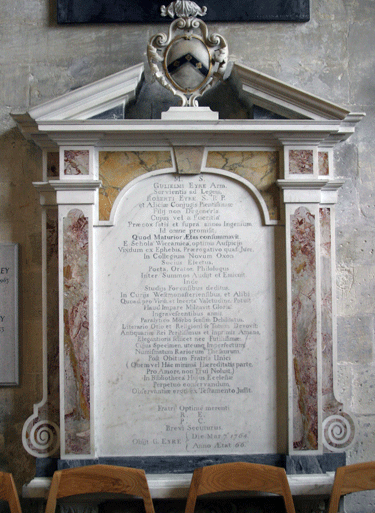 |
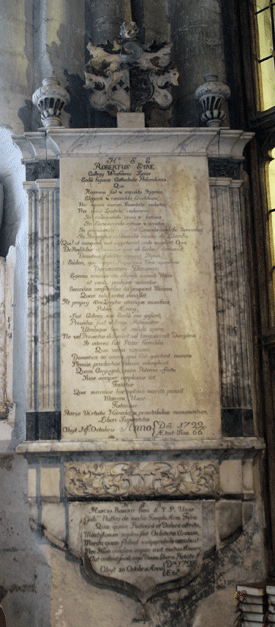 |
|
Warden Dr John Nicholas
(1712) By William Woodman of London |
Issac Walton
(1683) Fisherman and Author |
Catherine Eyre (1732) |
William Eyre (1764) Serjeant-at-Law |
Prebendary Dr Robert Eyre (1722) |
| The Nave |
| Chantry Chapels |
 |
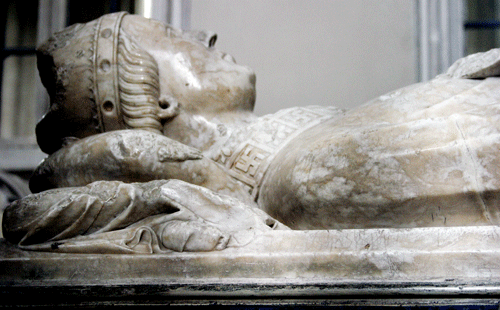 |
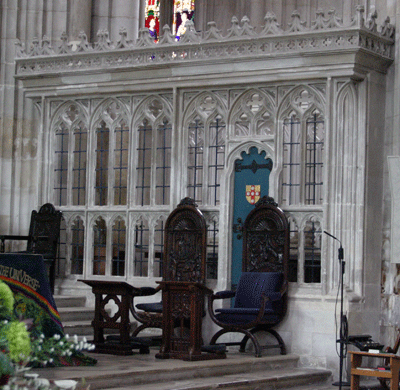 |
 |
|
Bishop
William of Eddington (1366)
Alabaster effigy & chapel from nave and
south transept. Purbeck marble tomb chest.
Note the fylfot - an ancient symbol
(borrowed by Nazi Germany as the swastika) - pattern and
inscription on amice and maniple. Arms. His
hands, now damaged, are in benediction not
in prayer. Chancellor under Edward III. He
was elected Archbishop of Canterbury but
declined and died shortly afterwards |
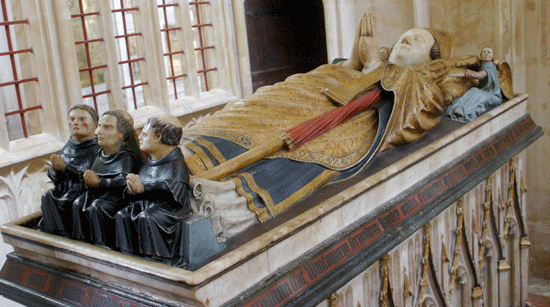  |
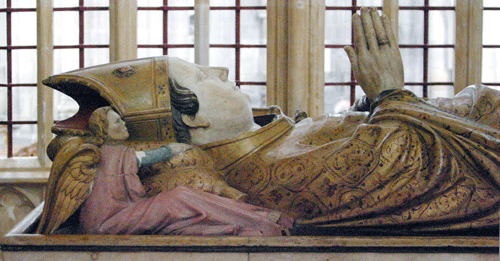 Bishop William of Wykeham (1404) Effigy and tomb chest of alabaster. Chantrey chapel from nave. Inscription of brass on the chamfer. Arms Restored 1894-97. Chancellor under Edward III. Opponent of John Wycliffe. He remodelled the nave transforming Walkelin's Norman nave to the Perpendicular style. Founder of Winchester College and New College Oxford. |
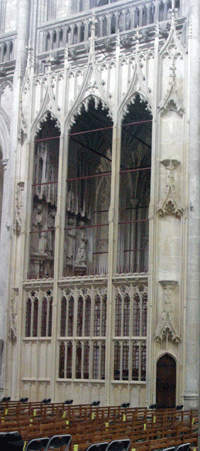 |
| Some Modern Bishops |
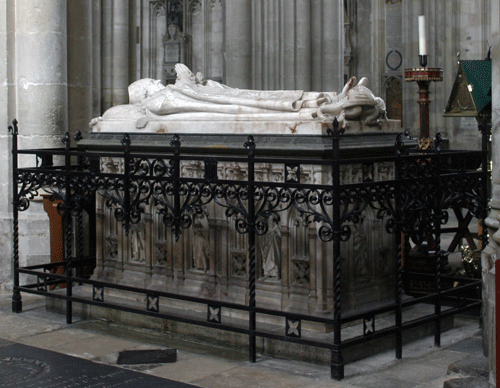 |
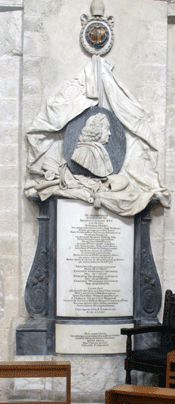 |
| Bishop Harold Browne (1891) Cenotaph designed by Bodley & Garner, executed by Farmer & Brindley. Buried at Westland, near Southhampton | Bishop William Hoadley (1761) A controversial, able and sincere man; he appointed prebendaries who were likewise able not just those who were well connected. Called by his opponents 'the greatest dissenter that ever held preferement in the church' & 'a vile republican'. |
| Nave - South Aisle |
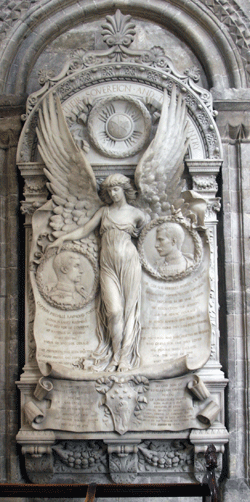 |
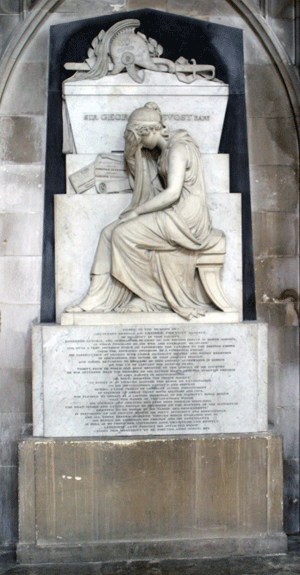 |
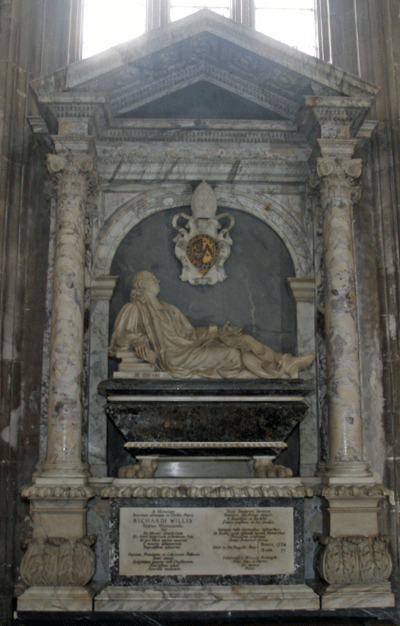 |
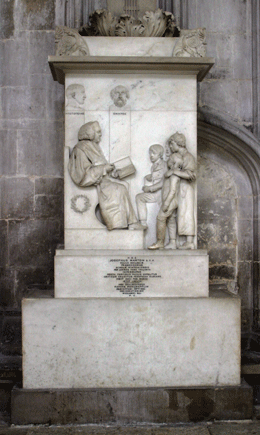 |
 |
| Captain Raymond Portal (1893) & Sir Gerald H Portal (1894) Brother diplomats, who died young. By Walso Story | Sir George Provost (1816) Marble by Chantrey. In 1811 appointed Governor-General of Canada and C-in-C of British Provinces in N. America | Bishop Willis (1734) by Sir Henry Cheere (signed). He reclines on a stack of books: he was one of the founders of SPCK. Note he faces west: an error said to have preyed on the sculptor's mind | Prependary Joseph Warton by Flaxman . Headmaster of Winchester College | Bishop Sir George Pretyman Tomline (1827) by R Westmacott Jnr. Friend and secretary of William Pitt, whose biography he wrote. |
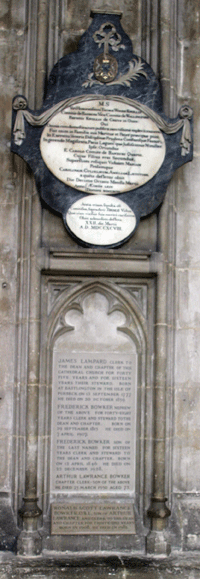 |
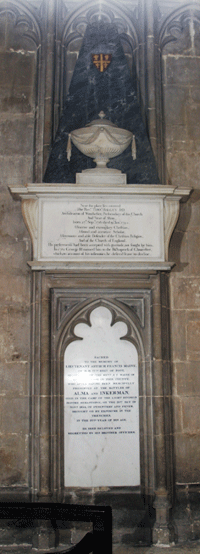 |
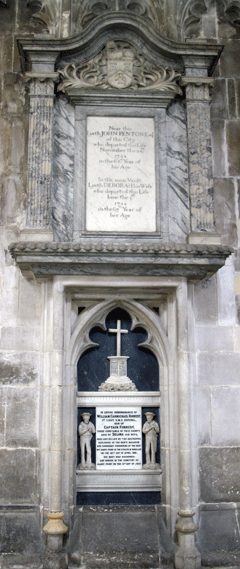 |
 |
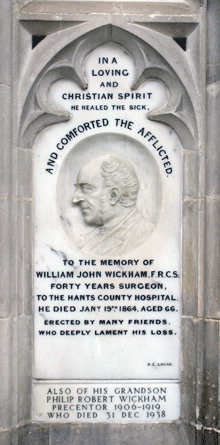 |
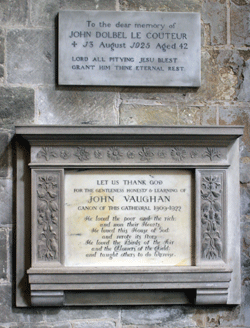 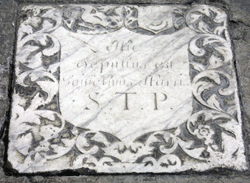 |
|
Top:
Thomas Woods Knollys, assumed Earl of
Banbury (1792) Borrom: James Lampard (1859), Chapter Clerk. His nephew, the latter's son and then his son, who also became chapter clerks. |
Top :
Archdeacon Dr Thomas Balguy (1795) He
declined the offer of the bishopric of Gloucester in
1781 on the grounds of ill-health. Bottom : Lt Athur Francis Maine (1854) Died of dysentry in trenches at Sebastopol (Crimean War) |
Top :
John (1724) & Deborah (1744 ) Pentone
Bottom: Lt William Carmichael (1881) & Selina Forrest . Killed by the explosion of his ship's magazine and its subsequent foundering; his body was recovered and buried at Sandy Point |
Top: Sir Roundell Palmer, 1st Earl
of Selbourne (1895) He served two terms of
Lord Chancellor (hence the wig) under
Gladstone. Buried at Selbourne. By F W
Pomeroy Bottom: Sir Henry Myers Elliot (1833) Indian Civil Service |
Mr William John Wickham FRCS (1864) Surgeon at Hants County Hospital for 40 years. White marble by R C Lucas |
Top:
John Dolbel Le Couteur (1925). Middle: Canon John Vaughan MA Canon of Wincheser 1909-22. He wrote the standard work: Winchester Cathedral: Its Monuments and Memorials (much consulted in preparing this page!) among others. Note the delightful plants and birds carved in low relief. Bottom: Below the the cartouche (see below) is this small marble stone marking his grave: Hic Sepultus est Gulielmus Harris S.TP. |
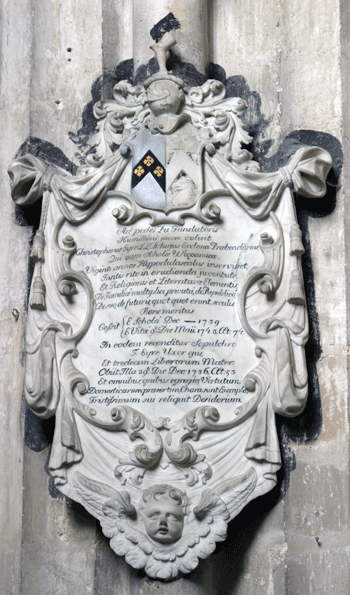 |
 |
| Prebendary Christopher Eyre MA (1743) Second Master, Winchester College. Cartouche fixed to the Wykeham Chantrey | Prebendary Dr William Harris STP (1700) Headmaster, Winchester College. Cartouche fixed to the Wykeham Chantrey. |
| Nave - North Aisle |
|
|
||||||||||
|
|||||||||||
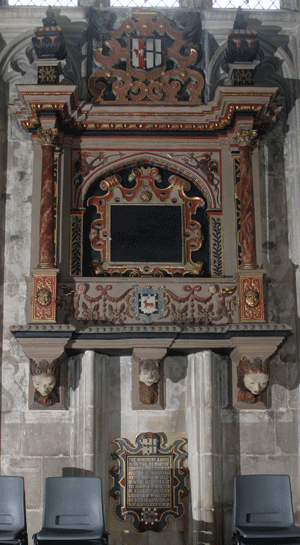 |
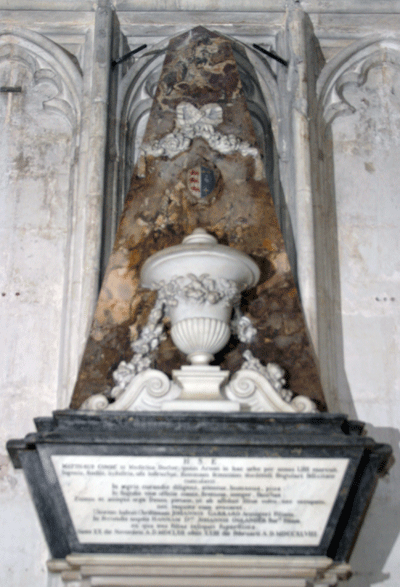 |
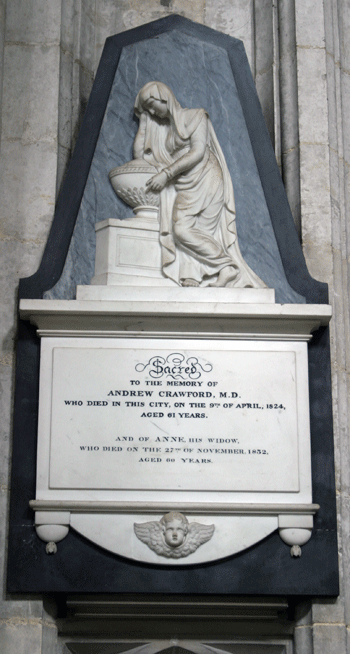 |
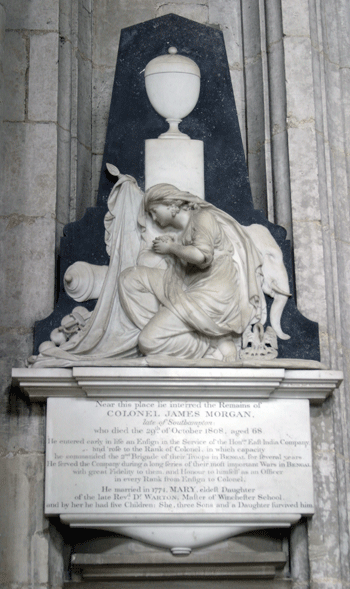 |
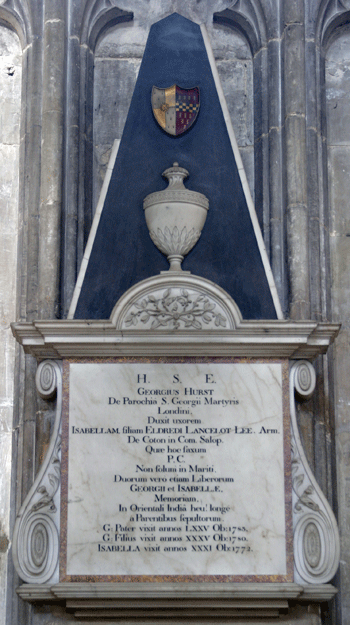 |
| Left:
Edward Cole (1617) Mayor
The inscription plate is curiously blank but a later
tablet below gives details Above: Dr Mathew Coombe MD (1748) 'He exercised his art with a singular hapiness in the City of Winchester' for 54 years. |
Dr Andrew Crawford MD (1824) |
Colonel
James Morgan (1808) He was the son-in-law of Dr Warton. By Bacon Jnr. Note the tiny pelican |
George Hurst (1793) & Isabella (1772) |
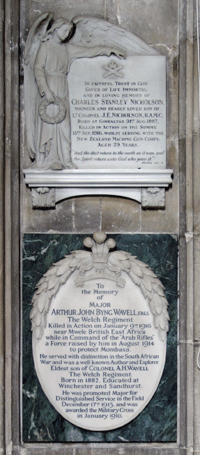 |
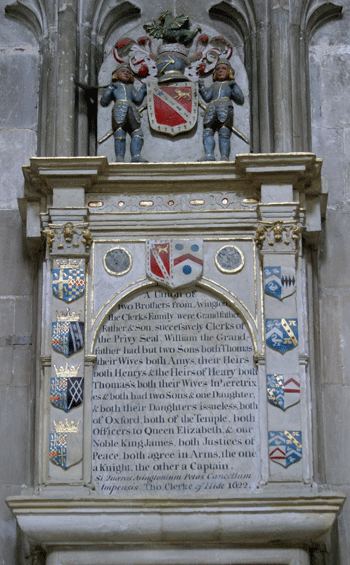 |
 |
| Top:
Charles Stanley Nicholson KIA 1916
The Somme Bottom: Mjr Arthur John Byng Wavell MC FRGS (1916) Author and explorer. KIA Mwele British East Africa |
Thomas Clerk of Hide (1629) The inscription refers to Avington church where they are more Clark monuments but the church was rebuilt and the monuments lost | Hon Edward Montagu MP (1775) & Elizabeth (1800) Founder of the Blue Stocking Club. She had requested that their infant son, who had died in 1744 and had been buried in Yorkshire, be reburied with his parents; this was carried out a month later |
| Please Note: The photographs above
were taken several years ago with an old digital camera and,
although I have attempted to edit them some are still
unsatisfactory. I now have new equipment and hope to return to
Winchester to retake most, if not all, of the photographs. My
idea was to include all the monuments in the cathedral but there
are several that I failed to record because they were either
inaccessible being roped off, hopefully temporarily, blocked by
chairs and other items or simply overlooked. Hopefully I can
remedy this in the future. |

